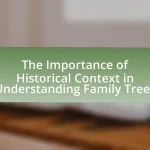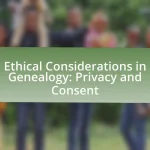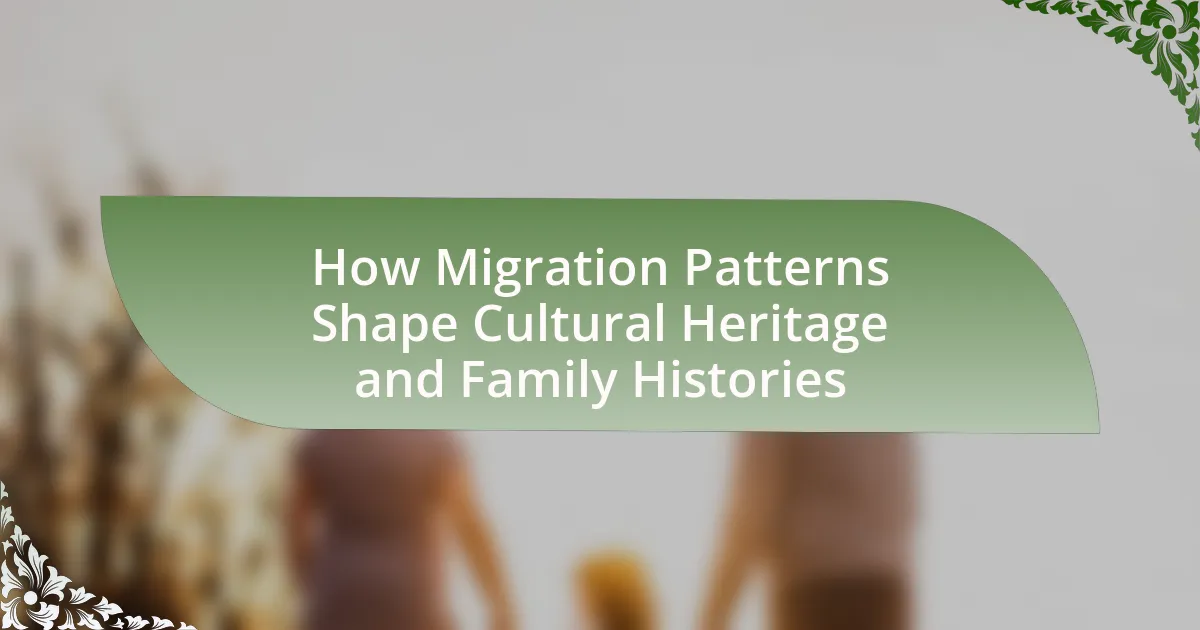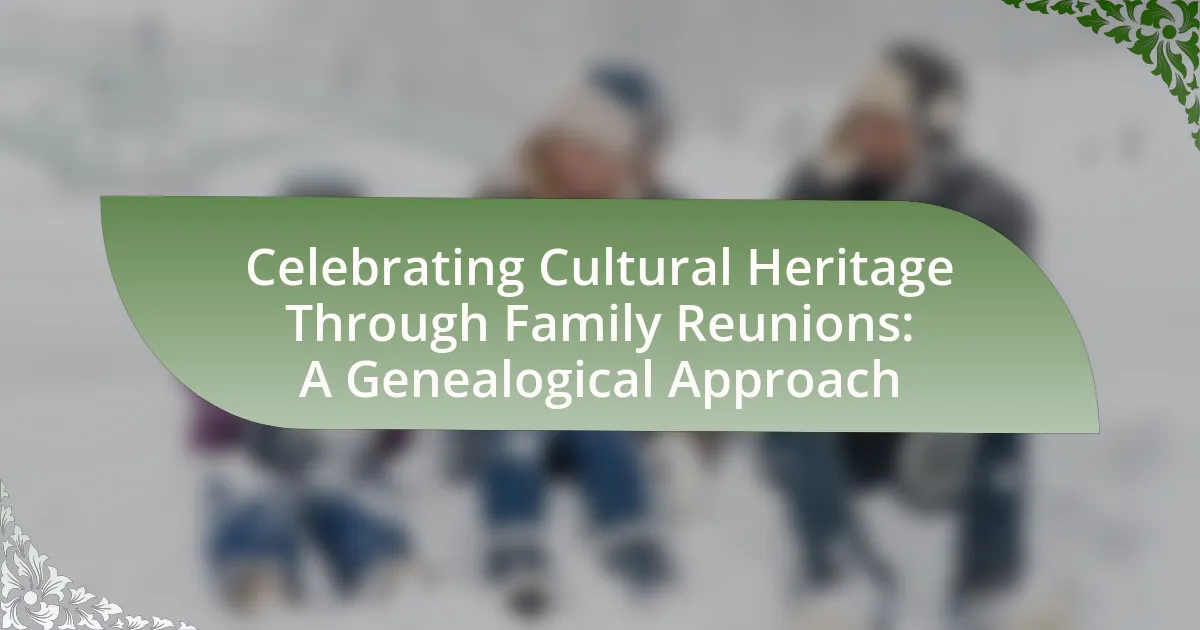Digital archives are organized collections of digitized materials that play a crucial role in preserving cultural heritage and facilitating genealogy research. They provide access to historical documents, photographs, audio recordings, and other artifacts, enhancing public engagement with history. The article explores how digital archives preserve cultural heritage, the types of materials they contain, and their significance for genealogy research. It also addresses the challenges faced by digital archives, including issues of accessibility and preservation, while highlighting future trends and innovations that aim to improve their functionality and user experience.
What are Digital Archives and Their Role in Cultural Heritage?
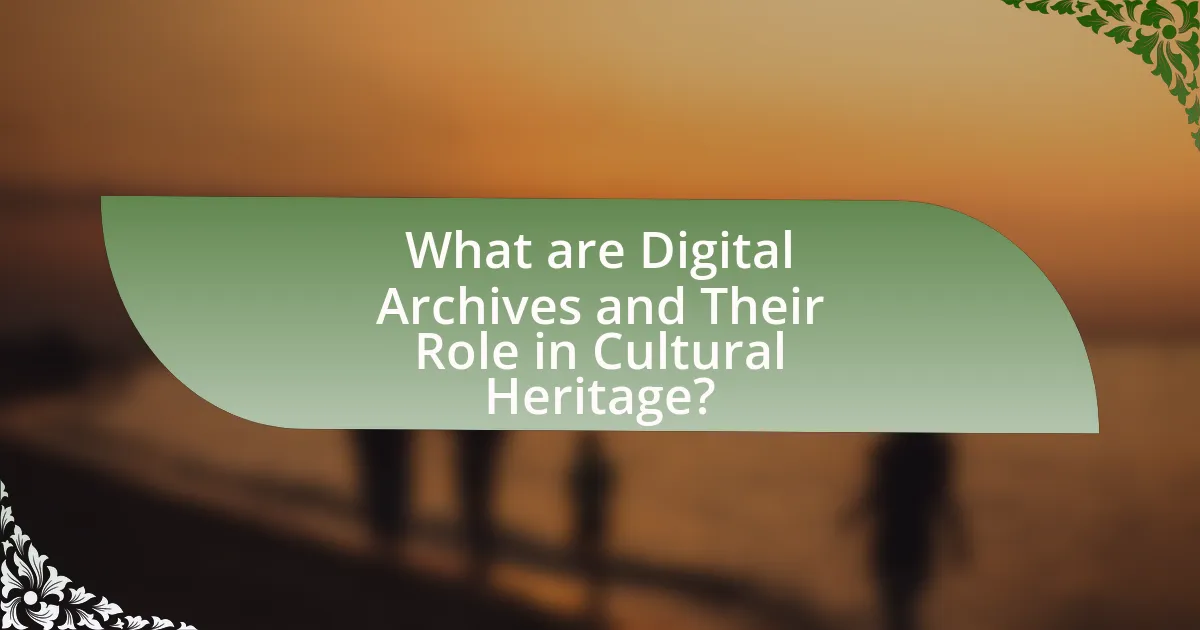
Digital archives are organized collections of digitized materials that preserve and provide access to historical documents, photographs, audio recordings, and other cultural artifacts. Their role in cultural heritage is significant as they facilitate the preservation, accessibility, and dissemination of cultural resources, enabling researchers, educators, and the public to engage with history in a meaningful way. For instance, the Library of Congress has digitized millions of items, making them available online, which enhances public access to American history and culture. This accessibility supports educational initiatives and fosters a deeper understanding of cultural narratives, ensuring that diverse histories are preserved for future generations.
How do Digital Archives preserve cultural heritage?
Digital archives preserve cultural heritage by digitizing and storing historical documents, artifacts, and multimedia resources, making them accessible to a global audience. This process ensures the longevity of cultural materials that may be at risk of deterioration or loss due to physical decay or environmental factors. For instance, the Library of Congress has digitized millions of items, allowing researchers and the public to access rare manuscripts and photographs online, thereby safeguarding these resources for future generations. Additionally, digital archives facilitate the preservation of diverse cultural narratives by providing platforms for underrepresented communities to share their histories, as seen in initiatives like the Digital Public Library of America, which aggregates content from various institutions to promote inclusivity in cultural heritage.
What types of materials are commonly found in Digital Archives?
Digital archives commonly contain a variety of materials, including photographs, documents, audio recordings, video files, and datasets. These materials serve to preserve cultural heritage and facilitate genealogy research by providing access to historical records, personal narratives, and visual documentation. For instance, many digital archives house digitized census records, birth and death certificates, and immigration documents, which are crucial for genealogical studies. Additionally, institutions like the Library of Congress and the National Archives have extensive digital collections that exemplify the types of materials available, showcasing the importance of these resources in connecting individuals with their ancestry and cultural history.
How do Digital Archives enhance accessibility to cultural heritage?
Digital archives enhance accessibility to cultural heritage by providing online platforms where diverse historical materials can be easily accessed by a global audience. These digital repositories allow users to explore documents, images, and artifacts that were previously limited to physical locations, thus democratizing access to cultural resources. For instance, the Digital Public Library of America hosts millions of photographs, manuscripts, and other items from libraries and museums across the United States, making them available to anyone with internet access. This shift not only preserves cultural heritage but also fosters greater engagement and education among users, as evidenced by increased online research and virtual exhibitions that attract wider participation.
Why are Digital Archives important for genealogy research?
Digital archives are crucial for genealogy research because they provide accessible, organized collections of historical records that facilitate the tracing of family lineages. These archives often include vital records such as birth, marriage, and death certificates, census data, and immigration records, which are essential for constructing accurate family trees. The digitization of these records allows researchers to access information from anywhere in the world, significantly speeding up the research process. For example, the U.S. National Archives has digitized millions of records, making them available online, which has greatly enhanced the ability of genealogists to uncover their ancestry.
What specific genealogical records can be found in Digital Archives?
Digital Archives contain specific genealogical records such as birth, marriage, and death certificates, census records, military service records, immigration and naturalization documents, and family trees. These records provide essential information for tracing lineage and understanding family history. For instance, census records can reveal household compositions and demographic details, while immigration documents often include names, dates, and places of origin, which are crucial for genealogical research.
How do Digital Archives support family history research?
Digital archives support family history research by providing accessible, organized collections of historical documents, photographs, and records that are essential for genealogical investigations. These archives often include census data, birth and death certificates, immigration records, and military service documents, which allow researchers to trace lineage and understand familial connections. For example, the U.S. National Archives offers digitized records that can be searched online, enabling users to find specific ancestors and their historical contexts efficiently. This accessibility enhances the ability of individuals to conduct thorough and informed family history research, bridging the gap between personal heritage and broader cultural narratives.
How do Digital Archives Bridge the Gap Between Cultural Heritage and Genealogy?
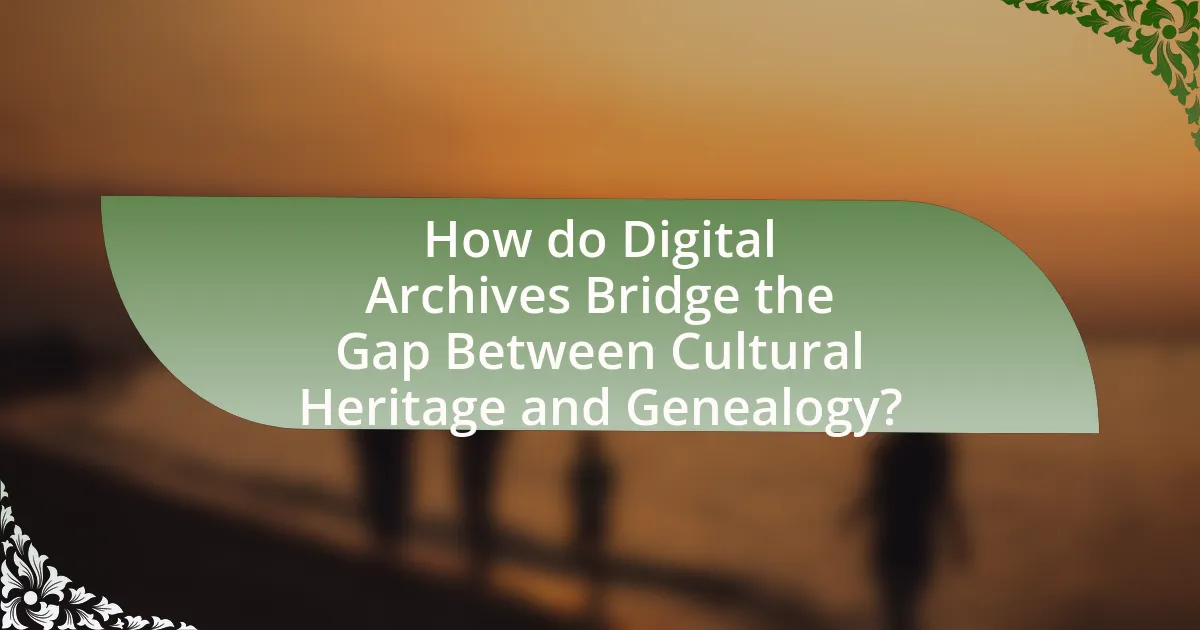
Digital archives bridge the gap between cultural heritage and genealogy by providing accessible, organized collections of historical documents, artifacts, and records that facilitate research into family histories and cultural narratives. These digital platforms allow users to explore a wide range of materials, such as census records, immigration documents, and photographs, which are essential for tracing lineage and understanding cultural backgrounds. For instance, the National Archives and Records Administration offers digitized records that genealogists can access to uncover ancestral connections, while simultaneously preserving cultural heritage by making these resources available to a global audience. This dual function enhances both personal and collective historical understanding, fostering a deeper appreciation of cultural identity and lineage.
What connections exist between cultural heritage and genealogy research?
Cultural heritage and genealogy research are interconnected as both fields seek to preserve and understand the history and identity of individuals and communities. Genealogy research often relies on cultural heritage to provide context for family histories, including traditions, languages, and historical events that shape familial identities. For instance, cultural heritage can inform genealogists about migration patterns, social structures, and historical narratives that influence family lineage. Additionally, digital archives serve as vital resources, offering access to historical documents, photographs, and records that enrich both cultural heritage and genealogy research, thereby enhancing the understanding of personal and collective histories.
How can understanding cultural heritage enhance genealogical research?
Understanding cultural heritage enhances genealogical research by providing context and depth to family histories. Cultural heritage encompasses traditions, languages, and historical experiences that shape identities, allowing researchers to connect familial lines to specific cultural narratives. For instance, knowledge of migration patterns, such as the Great Migration of African Americans in the early 20th century, can inform researchers about potential ancestral origins and movements. Additionally, cultural practices and naming conventions can reveal familial connections that might not be evident through standard genealogical records alone. This contextual understanding aids in interpreting historical documents, such as census records or immigration papers, leading to more accurate and enriched genealogical findings.
What role do Digital Archives play in connecting these two fields?
Digital archives serve as a crucial link between cultural heritage and genealogy research by providing accessible, organized collections of historical documents and artifacts. These archives facilitate the preservation and dissemination of cultural materials, such as birth records, immigration documents, and family histories, which are essential for genealogical research. For instance, the National Archives in the United States offers digitized records that allow researchers to trace lineage and understand familial connections, thereby enriching both personal and collective cultural narratives. This accessibility enhances the ability of individuals to explore their ancestry while simultaneously promoting awareness and appreciation of cultural heritage.
How do Digital Archives facilitate collaboration among researchers?
Digital archives facilitate collaboration among researchers by providing a centralized platform for accessing, sharing, and analyzing diverse datasets. These archives enable researchers to work together across geographical boundaries, allowing for the integration of various perspectives and expertise. For instance, the Digital Public Library of America hosts millions of digitized items from libraries, archives, and museums, promoting collaborative projects and interdisciplinary research. Additionally, tools within digital archives, such as shared annotations and version control, enhance communication and coordination among researchers, making it easier to build upon each other’s work.
What platforms or tools are available for researchers using Digital Archives?
Researchers using digital archives have access to several platforms and tools, including Archive.org, JSTOR, and Europeana. Archive.org provides a vast collection of digitized materials, including books, audio, and video, facilitating comprehensive research. JSTOR offers access to academic journals, books, and primary sources, which are essential for scholarly research. Europeana aggregates content from European cultural heritage institutions, allowing researchers to explore diverse historical documents and artifacts. These platforms enhance the accessibility and usability of digital archives for research purposes.
How can researchers contribute to Digital Archives?
Researchers can contribute to digital archives by creating, curating, and digitizing historical documents and artifacts. Their expertise allows them to identify significant materials that reflect cultural heritage, ensuring that these resources are preserved and made accessible to the public. For instance, researchers often collaborate with institutions to digitize rare manuscripts, photographs, and oral histories, which enhances the richness of digital archives. Additionally, they can contribute by developing metadata standards and best practices for archiving, which improves the discoverability and usability of digital collections. This collaborative effort not only aids in the preservation of cultural heritage but also supports genealogy research by providing valuable resources for individuals tracing their ancestry.
What Challenges Do Digital Archives Face in Supporting Cultural Heritage and Genealogy?
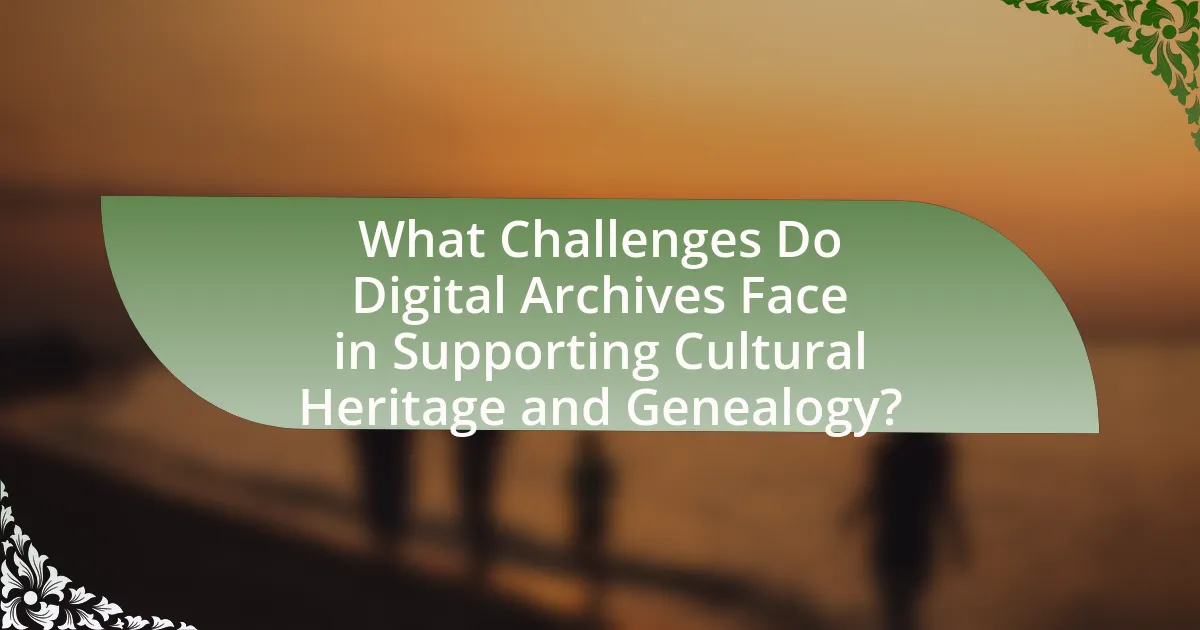
Digital archives face significant challenges in supporting cultural heritage and genealogy, primarily due to issues of accessibility, preservation, and data accuracy. Accessibility is hindered by technological barriers and the digital divide, which limits the ability of certain populations to access online resources. Preservation challenges arise from the need to maintain digital formats over time, as technology evolves and older formats become obsolete. Additionally, data accuracy is a concern, as digitized records may contain errors or incomplete information, which can mislead researchers and affect the integrity of genealogical research. These challenges are compounded by the need for ongoing funding and resources to sustain digital archive initiatives, as highlighted by studies indicating that many digital projects struggle to secure long-term financial support.
What are the common issues related to the preservation of Digital Archives?
Common issues related to the preservation of digital archives include technological obsolescence, data degradation, and inadequate metadata. Technological obsolescence occurs when software or hardware used to access or read digital files becomes outdated, making it difficult to retrieve information. Data degradation refers to the gradual loss of data integrity over time, often due to bit rot or file format changes. Inadequate metadata can hinder the discoverability and usability of archived materials, as insufficient descriptive information makes it challenging to locate and understand the context of the data. These issues collectively threaten the long-term accessibility and reliability of digital archives.
How does technology impact the longevity of Digital Archives?
Technology significantly enhances the longevity of digital archives by improving data storage, preservation techniques, and accessibility. Advanced storage solutions, such as cloud computing and redundant systems, ensure that digital files are less susceptible to loss due to hardware failure or natural disasters. Furthermore, technologies like digital preservation tools and formats (e.g., PDF/A, TIFF) help maintain the integrity and readability of archived materials over time. According to a study by the Digital Preservation Coalition, effective use of technology can extend the lifespan of digital content by up to 50 years, demonstrating its critical role in safeguarding cultural heritage and genealogical records.
What are the challenges in digitizing cultural heritage materials?
The challenges in digitizing cultural heritage materials include issues related to preservation, accessibility, and technological limitations. Preservation challenges arise from the fragility of original materials, which may deteriorate during the digitization process. Accessibility issues stem from the need for appropriate metadata and user-friendly interfaces to ensure that diverse audiences can engage with the digitized content. Technological limitations involve the high costs of digitization equipment and software, as well as the need for skilled personnel to manage the process effectively. According to a report by the International Council on Archives, these factors significantly hinder the comprehensive digitization of cultural heritage materials, impacting their availability for research and public use.
How can users effectively navigate Digital Archives for research?
Users can effectively navigate digital archives for research by utilizing advanced search features, applying relevant keywords, and filtering results based on specific criteria. Advanced search options often allow users to narrow down their queries by date, type of document, or subject matter, which enhances the precision of their research. For instance, many digital archives provide metadata that includes details such as authorship, publication dates, and subject tags, enabling users to refine their searches further. Additionally, familiarizing oneself with the archive’s organizational structure, such as collections or thematic categories, can significantly improve the efficiency of locating pertinent materials.
What strategies can enhance the search experience in Digital Archives?
Implementing advanced search algorithms, such as natural language processing and machine learning, can significantly enhance the search experience in digital archives. These technologies allow for more intuitive search queries, enabling users to find relevant information quickly and accurately. For instance, the use of semantic search improves the understanding of user intent and context, leading to more precise results. Additionally, incorporating metadata standards, like Dublin Core, ensures that archival materials are consistently described, facilitating easier discovery. Studies have shown that archives utilizing these strategies report increased user satisfaction and engagement, highlighting their effectiveness in improving search experiences.
What best practices should researchers follow when using Digital Archives?
Researchers should follow best practices such as verifying the authenticity of digital archives, ensuring proper citation of sources, and utilizing advanced search techniques to enhance their research efficiency. Verifying authenticity involves cross-referencing information with established databases or original documents to confirm accuracy. Proper citation is crucial for maintaining academic integrity and allows others to trace the origins of the information used. Advanced search techniques, including the use of specific keywords and filters, can significantly improve the relevance of search results, making it easier to locate pertinent materials within vast digital collections. These practices are supported by guidelines from organizations like the Society of American Archivists, which emphasizes the importance of critical evaluation and ethical use of archival materials.
What are the future trends for Digital Archives in cultural heritage and genealogy?
Future trends for digital archives in cultural heritage and genealogy include increased use of artificial intelligence for data organization and retrieval, enhanced accessibility through cloud-based platforms, and the integration of immersive technologies like virtual reality. These advancements aim to improve user engagement and facilitate research by making historical documents and artifacts more readily available. For instance, AI algorithms can analyze vast amounts of archival data to identify patterns and connections, thereby enriching genealogical research. Additionally, cloud storage solutions enable global access to digital archives, allowing researchers and the public to explore cultural heritage from anywhere. The adoption of virtual reality can provide immersive experiences, allowing users to interact with historical sites and artifacts in a more meaningful way.
How is technology evolving to improve Digital Archives?
Technology is evolving to improve digital archives through advancements in artificial intelligence, machine learning, and cloud storage solutions. These technologies enhance the organization, accessibility, and preservation of archival materials. For instance, AI algorithms can automate the digitization process, enabling faster and more accurate conversion of physical documents into digital formats. Machine learning techniques facilitate the categorization and tagging of archival content, making it easier for researchers to locate specific information. Additionally, cloud storage provides scalable solutions for storing vast amounts of data, ensuring that digital archives are secure and accessible from anywhere. These developments collectively contribute to a more efficient and user-friendly experience for those engaging with digital archives.
What innovations are on the horizon for genealogy research through Digital Archives?
Innovations on the horizon for genealogy research through digital archives include advanced artificial intelligence algorithms for record indexing, enhanced data visualization tools, and improved user interfaces for easier access to historical documents. These technologies will enable researchers to quickly analyze vast amounts of genealogical data, identify patterns, and connect disparate records. For instance, AI-driven image recognition can automate the transcription of handwritten documents, significantly speeding up the research process. Additionally, collaborative platforms are emerging that allow users to share findings and resources, fostering a community-driven approach to genealogy. These advancements are supported by ongoing investments in digital preservation and the increasing digitization of historical records by institutions worldwide.

